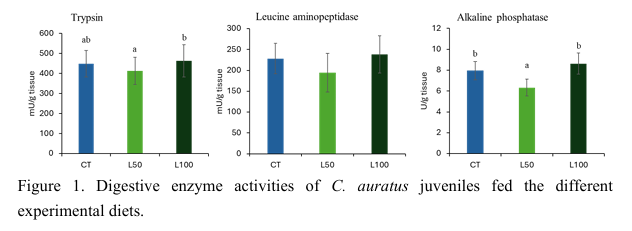EFFECT OF THE DIETARY INCLUSION OF A HYDROLYSED AND FERMENTED ALGAL BLEND ON GROWTH AND INTESTINE FUNCTIONALITY IN JUVENILE Chelon auratus
Introduction
The rising costs of fishmeal and fish oil have created the need to search for new feed ingredients, allowing these feedstuffs to be replaced by more sustainable and cost-effective alternatives while maintaining the nutritional value of aquafeeds. In this regard, algae appear as a promising option for inclusion in fish feed, due to their valuable nutritional value, making them a great source of protein, omega-3 polyunsaturated fatty acids, antioxidants, pigments, vitamins, and minerals, which can improve the health and development of animals (Galafat et al., 2024). In addition, species diversification can increase the competitiveness of the aquaculture sector. In this way, the golden grey mullet (Chelon auratus) emerges as a promising species due to its low dietary protein requirements and its high fillet quality (García-Márquez et al., 2024). However, the nutritional value of algae may be limited by the presence of a thick and complex cell wall, which hinders the bioavailability and accessibility of nutrients and intracellular compounds. Therefore, biotechnological pretreatments, such as enzymatic hydrolysis or microbial fermentation, become essential, as they have been shown to improve nutrient bioavailability (Vizcaíno et al., 2024). For this reason, the aim of this study was to evaluate the dietary inclusion of a hydrolysed and fermented algal blend on the growth and digestive functionality in Chelon auratus juveniles.
Material and Methods
The algal blend used contained 30% Arthrospira sp., 20% Chlorella sp., 10% Microchloropsis sp., 10% Tisochrysis sp., and 30% Ulva sp. It was supplied by the company LifeBioencapsulation S.L. (Almería, Spain) and stored at -20 °C until use. A sequential biotechnological process was carried out, first subjecting the algal biomass to enzymatic hydrolysis with a mixture of hydrolytic enzymes (carbohydrases, cellulase, and proteases) during 5 h, and then followed by microbial fermentation using 10⁹ CFU/mL of S. cerevisiae and 10⁹ CFU/mL of B. subtilis for 36 h.
A 62-day feeding trial was conducted at the Marine Culture Facility of the University of Cádiz. For this purpose, two experimental diets, L50 and L100, were formulated to replace 50% and 100% of the fishmeal and fish oil, along with a control diet (CT) including 15% fishmeal and 5% fish oil without algal biomass. At the end of the trial, fish growth was analyzed, and biological samples were collected to evaluate the proximal composition of
the muscle, digestive enzyme activities, and the ultrastructure of the intestinal mucosa.
Results and Discussion
On the one hand, no significant differences were observed in growth performance among treatments. Similarly, the proximal composition of the muscle showed no differences, except for the total lipid content, which was higher in the L100 group. On the other hand, enzymatic activity assays showed that trypsin and alkaline phosphatase activities were significantly higher in the fish fed the L100 diet compared to the CT group (Figure 1), which could indicate an improvement in the digestive capacity of these fish. In addition, scanning electron microscopy (SEM) images showed a healthy intestinal mucosa, with no signs of damage in any of the treatments evaluated. Results obtained confirmed the suitability of total replacement of fishmeal and fish oil in practical diets for this fish species.
Acknowledgments
This research was supported by the ALFIL project (TED2021-132290B-I00), funded by MCIN/AEI/10.13039/501100011033 and co-funded by the European Union ‘NextGenerationEU’/PRTR. The research contribution from the University of Almería spin-off Lifebioencapsulation SL was funded by European Union’s Horizon 2020 research and innovation program under grant agreement No. 101036768 (NeoGiANT project) and the ULVACTIVE project (PID2023-152514OB-C21), funded by MCIN/AEI. Project (project code ThinkInazul) funded with resources from the «Next Generation EU» Recovery Fund through the Recovery, Transformation and Resilience Plan and cofinanced by the Consejería de Universidad, Investigación e Innovación de la Administración de la Junta de Andalucía. The views and opinions expressed are solely those of the author(s) and do not necessarily reflect those of the European Union or the European Commission. Neither the European Union nor the European Commission are responsible for them. The authors gratefully acknowledge C.I.F.P. Marítimo Zaporito for the kind provision of fish used in this study.
Reference
Galafat A, Sáez MI, Rodríguez C, et al. (2024). In vitro evaluation of algae and their effect as dietary ingredient on growth, chemical composition and intestinal functionality in juvenile turbot (Scophthalmus maximus). Aquaculture 592, 741208.
García-Márquez J, Álvarez-Torres D, Cerezo IM, et al. (2024). Effects of Chlorella fuscasupplemented diet on intestinal microbiota and gene expression related to metabolism, stress, and immune response in Chelon auratus, Algal Research 77, 103362.
Vizcaíno AJ, Sáez MI, Galafat A, et al. (2024). Effects of feeding European seabass (Dicentrarchus labrax) juveniles with crude, hydrolysed and fermented biomass of the invasive macroalga Rugulopteryx okamurae (Ochrophyta). Aquaculture Reports 34, 101877.
